
The double-headed eagle is an iconographic symbol originating in the Bronze Age. The earliest predecessors of the symbol can be found in Mycenaean Greece and in the Ancient Near East, especially in Mesopotamian and Hittite iconography. Most modern uses of the emblem are directly or indirectly associated with its use by the Palaiologos dynasty of the Byzantine Empire, a use possibly derived from the Roman Imperial Aquila. High medieval iterations of the motif can be found in Islamic Spain, France, the Bulgarian Empire and the Serbian principality of Raška. From the 13th century onward it appeared within the Islamic world in the Seljuk Sultanate of Rum and the Mamluk Sultanate, and within the Christian world in Albania, the Holy Roman Empire, Russia, and Serbia. In a few places, among them the Holy Roman Empire and Russia, the motif was further augmented to create the less prominent triple-headed eagle.
History
Bronze Age

Many-headed mythological beasts and bird creatures frequently appear in the Bronze Age and Iron Age pictorial legacy of the Ancient Near East, especially in Mesopotamia. They were later adopted by the Hittites. Use of the double-headed eagle in Hittite imagery has been interpreted as "royal insignia". A monumental Hittite relief of a double-headed eagle grasping two hares is found at the eastern pier of the Sphinx Gate at Alaca Hüyük. For more examples of double-headed eagles in the Hittite context see Jesse David Chariton, "The Function of the Double-Headed Eagle at Yazılıkaya."
In Mycenaean Greece, erroneous evidence for the double-eagle motif was found in Grave Circle A, an elite Mycenaean cemetery; the motif was part of a series of gold jewelry, possibly a necklace with a repeating design of two birds sitting chest facing each other with their heads and faces turned in the opposite directions. Some found the motif to bear resemblance to the double-headed god symbol of Sumeria and BMAC culture of south central Asia.
Middle Ages

After the Bronze Age collapse, there is a gap of more than two millennia before the re-appearance of the double-headed eagle motif. The earliest occurrence in the context of the Byzantine Empire appears to be on a silk brocade dated to the 10th century, which was, however, likely manufactured in Islamic Spain; similarly early examples, from the 10th or 11th century, are from Bulgaria and from France.
Adoption in the Byzantine Empire
The early Byzantine Empire continued to use the (single-headed) imperial eagle motif. The double-headed eagle appears only in the medieval period, by about the 10th century in Byzantine art, but as an imperial emblem only much later, during the final century of the Palaiologos dynasty. In Western European sources, it appears as a Byzantine state emblem since at least the 15th century.
A modern theory, forwarded by Zapheiriou (1947), connected the introduction of the motif to Byzantine Emperor Isaac I Komnenos (1057–1059), whose family originated in Paphlagonia. Zapheiriou supposed that the Hittite motif of the double-headed bird, associated with the Paphlagonian city of Gangra (where it was known as Haga, Χάγκα), might have been brought to the Byzantine Empire by the Komnenoi.
Adoption in the Turkic and Muslim world

The double-headed eagle motif was adopted in the Seljuk Sultanate of Rûm and the Turkic beyliks of medieval Anatolia in the early 13th century. A royal association of the motif is suggested by its appearance on the keystone of an arch of the citadel built at Konya (Ikonion) under Kayqubad I (r. 1220–1237). The motif appears on Turkomen coins of this era, notably on coins minted under Artuqid ruler Nasir al-Din Mahmud of Hasankeyf (r. 1200–1222). It is also found on some stone reliefs on the towers of Diyarbakır Fortress.
Later in the 13th century, the motif was also adopted in Mamluk Egypt; it is notably found on the pierced-globe handwarmer made for Mamluk amir Badr al-Din Baysari (c. 1270), and in a stone relief on the walls of the Cairo Citadel.
Adoption in Christian Europe

Adoption of the double-headed eagle in Serbia, Albania, Russia and in the Holy Roman Empire begins still in the medieval period, possibly as early as the 12th century, but widespread use begins after the fall of Constantinople, in the late 15th century.
The oldest preserved depiction of a double-headed eagle in Serbia is the one found in the donor portrait of Miroslav of Hum in the Church of St. Peter and Paul in Bijelo Polje, dating to 1190. The double-headed eagle in the Serbian royal coat of arms is well attested in the 13th and 14th centuries.
An exceptional medieval depiction of a double-headed eagle in the West, attributed to Otto IV, is found in a copy of the Chronica Majora of Matthew of Paris (Corpus Christi College, Cambridge, Parker MS 16 fol. 18, 13th century).
-
 Drawing of the double-headed eagle as shown in the donor portrait of Miroslav of Hum in Bijelo Polje (1190)
Drawing of the double-headed eagle as shown in the donor portrait of Miroslav of Hum in Bijelo Polje (1190)
-
 First double-headed eagle as Reichsadler, from Chronica Majora (c. 1250)
First double-headed eagle as Reichsadler, from Chronica Majora (c. 1250)
-
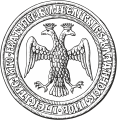 Seal of Ivan III of Russia (1472)
Seal of Ivan III of Russia (1472)
Early Modern use
Serbia





 Left to Right: 1. Nemanjic Dynasty. 2. 11th c. in Serbian Orthodox Hilandar Monastery. 3. 13th c. in Žiča Monastery. 4. In Ljubostinja Monastery. 5. Serbian Eagle Flag and Serbian cross. 6. Serbian Prince Lazar Coat of Arms
Main article: Serbian eagle
Further information: Coat of arms of Serbia
Left to Right: 1. Nemanjic Dynasty. 2. 11th c. in Serbian Orthodox Hilandar Monastery. 3. 13th c. in Žiča Monastery. 4. In Ljubostinja Monastery. 5. Serbian Eagle Flag and Serbian cross. 6. Serbian Prince Lazar Coat of Arms
Main article: Serbian eagle
Further information: Coat of arms of Serbia
In Serbia, the Serbian Orthodox Nemanjić dynasty adopted a double-headed eagle by the 11th century by Serbian great prince Miroslav (later recorded by Angelino Dulcert 1339 during Serbian Empire). The double-headed eagle was used in several coats of arms found in the Illyrian Armorials, compiled in the early modern period. The white double-headed eagle on a red shield was used for the Serbian Kingdom Nemanjić dynasty, and the Despot Stefan Lazarević. A "Nemanjić eagle" was used at the crest of the Hrebeljanović (Lazarević dynasty), while a half-white half-red eagle was used at the crest of the Mrnjavčević. Use of the white eagle was continued by the modern Karađorđević and Obrenović ruling houses.
Albania





 Left to Right: 1. Double-headed eagle on the official seal of Skanderbeg, the Lord of Albania (D · AL Dominus Albaniae). 2. Principality of Arianiti. 3. Engjëlli family. 4. Statutes of Scutari. 5. Dukagjini family. 6. Albanian General Gjergj Basta Coat of Arms
Main articles: Coat of arms of Albania and Armorial of Albania
Left to Right: 1. Double-headed eagle on the official seal of Skanderbeg, the Lord of Albania (D · AL Dominus Albaniae). 2. Principality of Arianiti. 3. Engjëlli family. 4. Statutes of Scutari. 5. Dukagjini family. 6. Albanian General Gjergj Basta Coat of Arms
Main articles: Coat of arms of Albania and Armorial of AlbaniaThe Kastrioti family in Albania had a double-headed eagle as their emblem in the 14th and 15th centuries. Some members of the Dukagjini family and the Arianiti family also used double-headed eagles, and a coalition of Albanian states in the 15th century, later called the League of Lezhë, also used the Kastrioti eagle as its flag. The current flag of Albania features a black two-headed eagle with a crimson background. During John Hunyadi's campaign in Niš in 1443, Skanderbeg and a few hundred Albanians defected from the Turkish ranks and used the double-headed eagle flag. The eagle was used for heraldic purposes in the Middle Ages by a number of Albanian noble families and became the symbol of the Albanians. The Kastrioti's coat of arms, depicting a black double-headed eagle on a red field, became famous when he led a revolt against the Ottoman Empire resulting in the independence of Albania from 1443 to 1479. This was the flag of the League of Lezhë, which was the first unified Albanian state in the Middle Ages and the oldest Parliament with extant records.
Russia
Main article: Coat of arms of Russia
After the fall of Constantinople, the use of two-headed eagle symbols spread to Grand Duchy of Moscow after Ivan III's second marriage (1472) to Zoe Palaiologina (a niece of the last Byzantine emperor Constantine XI Palaiologos, who reigned 1449–1453), The last prince of Tver, Mikhail III of Tver (1453–1505), was stamping his coins with two-headed eagle symbol. The double-headed eagle remained an important motif in the heraldry of the imperial families of Russia (the House of Romanov (1613–1762)).
The double-headed eagle was a main element of the coat of arms of the Russian Empire (1721–1917), modified in various ways from the reign of Ivan III (1462–1505) onwards, with the shape of the eagle getting its definite Russian form during the reign of Peter the Great (1682–1725). It continued in Russian use until abolished (being identified with Tsarist rule) with the Russian Revolution in 1917; it was restored in 1993 after that year's constitutional crisis and remains in use up to the present, although the eagle charge on the present coat of arms is golden rather than the traditional, imperial black. It is also widely used by federal agencies.
Holy Roman Empire
Main article: Reichsadler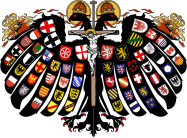 The Quaternion Eagle of the Holy Roman Empire c. 1510
The Quaternion Eagle of the Holy Roman Empire c. 1510 Emperor Maximilian with the Imperial Banner, c. 1515
Emperor Maximilian with the Imperial Banner, c. 1515
Use of a double-headed Imperial Eagle, improved from the single-headed Imperial Eagle used in the high medieval period, became current in the 15th to 16th centuries. The double-headed Reichsadler was in the coats of arms of many German cities and aristocratic families in the early modern period. A distinguishing feature of the Holy Roman eagle was that it was often depicted with haloes. In the 16th century, the double-headed eagle was the most powerful heraldic mark up to that time, as it symbolized the union of the imperial dignity of the Holy Roman Empire (the Habsburg empire) with the Spanish Monarchy. The double-headed eagle would end up being the emblem of the Habsburgs in Madrid and Vienna, becoming universal with the global expansion of the Spanish empire.
After the dissolution of the Holy Roman Empire in 1806, the double-headed eagle was retained by the Austrian Empire, and served also as the coat of arms of the German Confederation. The German states of Schwarzburg-Rudolstadt and Schwarzburg-Sondershausen continued to use the double-headed eagle as well until they were abolished shortly after the First World War, and so did the Free City of Lübeck until it was abolished by the Nazi government in 1937. Austria, which switched to a single-headed eagle after the end of the monarchy, briefly used a double-headed eagle – with haloes – once again when it was a one-party state 1934–1938; this, too, was ended by the Nazi government. Since then, Germany and Austria, and their respective states, have not used double-headed eagles.
Mysore (India)
Main article: Gandaberunda
The Gandaberunda is a bicephalous bird, not necessarily an eagle but very similar in design to the double-headed eagle used in Western heraldry, used as a symbol by the Wadiyar dynasty of the Kingdom of Mysore from the 16th century. Coins (gold pagoda or gadyana) from the rule of Achyuta Deva Raya (reigned 1529–1542) depicted the Gandaberunda. Of similar age is a sculpture on the roof of the Rameshwara temple in the temple town of Keladi in Shivamogga. The symbol was in continued use by the Maharaja of Mysore into the modern period, and was adopted as the state symbol of the State of Mysore (now Karnataka) after Indian independence.
Modern use
Albania, Serbia, Montenegro and Russia have a double-headed eagle in their coat of arms. In 1912, Ismail Qemali raised a similar version of that flag. The flag has gone through many alterations, until 1992 when the current flag of Albania was introduced.
The double-headed eagle is now used as an emblem by a number of Orthodox Christian churches, including the Greek Orthodox Church and the Orthodox Autocephalous Church of Albania. In modern Greece, it appears in official use in the Hellenic Army (coat of arms of Hellenic Army General Staff) and the Hellenic Army XVI Infantry Division,
The two-headed eagle appears, often as a supporter, on the modern and historical arms and flags of Austria-Hungary, the Kingdom of Yugoslavia, Austria (1934–1938), Albania, Armenia, Montenegro, Russia and Serbia. It was also used as a charge on the Greek coat of arms for a brief period in 1925–1926. It is also used in the municipal arms of a number of cities in Germany, Netherlands and Serbia, the arms and flag of the city and province of Toledo, Spain, the arms of the town of Velletri, Italy, and the arms and flag of the city of Rijeka, Croatia.
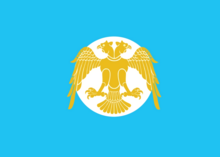
An English heraldic tradition, apparently going back to the 17th century, attributes coats of arms with double-headed eagles to the Anglo-Saxon earls of Mercia, Leofwine and Leofric. The design was introduced in a number of British municipal coats of arms in the 20th century, such as the Municipal Borough of Wimbledon in London, the supporters in the coat of arms of the city and burgh of Perth, and hence in that of the district of Perth and Kinross (1975). The motif is also found in a number of British family coats of arms. In Turkey, General Directorate of Security, the municipalities of Diyarbakır and Konya, as well as Konyaspor and Erzurumspor F.K. football clubs have a double-headed eagle in their coat of arms.
Scottish Rite of Freemasonry
The Double-Headed Eagle is used as an emblem by the Scottish Rite of Freemasonry which was introduced in France, in the early 1760s, as the emblem of the Kadosh degree. The Ancient and Accepted Scottish Rite of Freemasonry, adopted the 'Double Headed Eagle of Lagash' as its emblem since the 1758 establishment of the Masonic Chivalry Rite (Council of Emperors of the East and West), in Paris, France. That council, with a Masonic rite of twenty-five degrees, set the foundation for what would evolve into the present masonic system Scottish Rite. The successors of the "Council of Emperors of the East and West" are today the various Supreme Councils of the Thirty Third Degree in more than 60 countries. The Double Headed Eagle was formally adopted from the personal emblem of King Frederick the Great, of Prussia, who in 1786 became the First Sovereign Grand Commander of the Supreme Council of the 33 Degree, subsequent to its formation following the adoption of eight additional degrees to the Masonic Rite.
Sports clubs insignia
Several sports clubs, mainly Greek and Turkish, have the double-headed eagle in their insignia. Some of them are: three football clubs of Turkey; Çorum FK, BB Erzurumspor, Konyaspor, Amed SFK and the Greek sport clubs AEK (Athletic Union of Constantinople) and (since 1929 when it adopted the emblem of its parent association Enosis Konstantinopoliton Thessalonikis which was founded in 1923) P.A.O.K. (Panthesalonikios Athletic club of Constantinople). The Greek clubs use this symbol since both were founded by Greek refugees who moved to Greece from Constantinople in the 1920s. It is also the emblem of the Dutch clubs NEC and Vitesse Arnhem, the English football club AFC Wimbledon and Scottish side Saint Johnstone FC. The Gandabherunda insignia is used by the Indian club Bengaluru FC in their logo.
Gallery
Heraldry and vexillology
-
 Imperial Banner of the Holy Roman Empire, modern re-creation
Imperial Banner of the Holy Roman Empire, modern re-creation
-
 Greater coat of arms of Charles V, Holy Roman Emperor and King of Spain
Greater coat of arms of Charles V, Holy Roman Emperor and King of Spain
-
 Coat of arms of Frederick Augustus II, Elector of Saxony
Coat of arms of Frederick Augustus II, Elector of Saxony
-
 1776 proposal for the Great Seal of the United States with a double-headed eagle as the symbol for German Americans
1776 proposal for the Great Seal of the United States with a double-headed eagle as the symbol for German Americans
-
 Coat of arms of the Antwerp Province, Belgium. A banner of arms is also depicted in the Greater coat of arms of Belgium
Coat of arms of the Antwerp Province, Belgium. A banner of arms is also depicted in the Greater coat of arms of Belgium
-
 Coat of arms of Ninove, Belgium
Coat of arms of Ninove, Belgium
-
 Coat of arms of Perth, Scotland
Coat of arms of Perth, Scotland
-
 Coat of arms of the Austrian Empire (1815–1867)
Coat of arms of the Austrian Empire (1815–1867)
-
 Kingdom of Lombardy–Venetia (1815–1866), a crown land of the Austrian Empire
Kingdom of Lombardy–Venetia (1815–1866), a crown land of the Austrian Empire
-
 Coat of arms of the Federal State of Austria (1934–1938)
Coat of arms of the Federal State of Austria (1934–1938)
-
 Coat of arms of Serbia (1882–1918 and since 2004)
Coat of arms of Serbia (1882–1918 and since 2004)
-
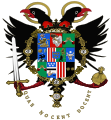 Arms of the Cantacuzino family in the Kingdom of Romania (circa 1900)
Arms of the Cantacuzino family in the Kingdom of Romania (circa 1900)
-
 Coat of arms of Albania
Coat of arms of Albania
-
 Badge of the Mercian Brigade (1948–64) and current badge of the Mercian Regiment reformed in 2007
Badge of the Mercian Brigade (1948–64) and current badge of the Mercian Regiment reformed in 2007
-
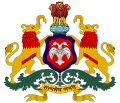 Coat of arms of Karnataka, India
Coat of arms of Karnataka, India
-
 Flag used by the Greek Orthodox Church and Mount Athos since the later 20th century
Flag used by the Greek Orthodox Church and Mount Athos since the later 20th century
-
 Coat of arms of the Russian Empire
Coat of arms of the Russian Empire
-
 Coat of arms of Armenia (1992–) with a double-headed eagle as the symbol for the Artaxiad and Arsacid dynasties
Coat of arms of Armenia (1992–) with a double-headed eagle as the symbol for the Artaxiad and Arsacid dynasties
-
 Coat of arms of the Russian Federation (1993–)
Coat of arms of the Russian Federation (1993–)
-
 Coat of arms of Chernihiv Oblast, Ukraine (2000–)
Coat of arms of Chernihiv Oblast, Ukraine (2000–)
-
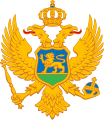 Coat of arms of Montenegro (2004–)
Coat of arms of Montenegro (2004–)
-
 Coat of arms of the 1st-54 Regulares Battalion "Tetuán" (Spanish Army)
Coat of arms of the 1st-54 Regulares Battalion "Tetuán" (Spanish Army)
-
 Coat of arms of Potosi, Bolivia
Coat of arms of Potosi, Bolivia
Artwork
-
 A double-headed eagle relief, 13th-century, Divriği Great Mosque and Hospital, Sivas Province
A double-headed eagle relief, 13th-century, Divriği Great Mosque and Hospital, Sivas Province
-
 Sculpture of double-headed eagle on the Seat of the Archbishopric of Athens
Sculpture of double-headed eagle on the Seat of the Archbishopric of Athens
-
 Sculpture of double-headed eagle on the top of Stari Dvor, Belgrade
Sculpture of double-headed eagle on the top of Stari Dvor, Belgrade
-
 Sculpture of double-headed eagle on the top of Novi Dvor, Belgrade
Sculpture of double-headed eagle on the top of Novi Dvor, Belgrade
-
 Sculpture of double-headed eagle on the top of Hofburg, Vienna
Sculpture of double-headed eagle on the top of Hofburg, Vienna
-
 Sculpture of double-headed eagle on the top of Schönbrunn Palace, Vienna
Sculpture of double-headed eagle on the top of Schönbrunn Palace, Vienna
-
Sculpture of double-headed eagle on the top of Old Post Office, Melk
-
 Sculpture of double-headed eagle on the top of an Austrian Monument in Leipzig
Sculpture of double-headed eagle on the top of an Austrian Monument in Leipzig
-
 Sculpture of double-headed eagle on the top of the Stone of the Empress, which located at the Market Square, Helsinki
Sculpture of double-headed eagle on the top of the Stone of the Empress, which located at the Market Square, Helsinki
-
 Sculpture of double-headed eagle on the gate of Alexander Garden in Moscow
Sculpture of double-headed eagle on the gate of Alexander Garden in Moscow
-
 An anti-Austrian cartoon for the Five Days of Milan
An anti-Austrian cartoon for the Five Days of Milan
-
 In the painting Attack by Edvard Isto, the Double-headed eagle is tearing away the law book from the Finnish Maiden.
In the painting Attack by Edvard Isto, the Double-headed eagle is tearing away the law book from the Finnish Maiden.
-
 In the painting Sanctified Kosovo by Dragutin Inkiostri Medenjak, the Double-headed eagle is holding the Serbian flag in one claw, and ripping the flag of the Ottoman Empire in the other.
In the painting Sanctified Kosovo by Dragutin Inkiostri Medenjak, the Double-headed eagle is holding the Serbian flag in one claw, and ripping the flag of the Ottoman Empire in the other.
See also
- Arms of Skanderbeg
- Coat of arms of Serbia and Montenegro
- Coat of arms of Austria-Hungary
- Crossed hands
- Hawk of Quraish
- Three-legged crow
References
- Eiland, Murray (2013). "Some Problems of Islamic Heraldry". The Armiger's News. 35 (2): 1–5 – via academia.edu.
- Hameeuw, Hendrik (2021). "Double-headed Bird Creatures in Third Millennium Mesopotamian Iconography". Orientalia Lovaniensia Analecta. 302: 31–148.
- ^ Chariton, Jesse David (2011). "The Mesopotamian Origins of the Hittite Double-Headed Eagle". UW-L Journal of Undergraduate Research. XIV – via ResearchGate.
- Collins, Billie Jean. 2010 "Animal Mastery in Hittite Art and Texts" in The Master of Animals in Old World Iconography, ed. Derek B. Counts and Bettina Arnold, pp. 59-74. Main Series, Number 24, Archaeolingua Foundation, Budapest.
- Chariton, Jesse David (2008). "The Function of the Double-Headed Eagle at Yazılıkaya" (PDF). UW-L Archaeology Senior Theses – via Minds@UW.
- Harvard Art Museums/Arthur M. Sackler Museum, Museum Purchase. "Reproduction of a Gold Mycenaean Ornament", 1901.
- ^ Reconstructed by the Abegg Stiftung Riggisberg, Switzerland. P. Ackermann: A Gold-woven Byzantine Silk of the Tenth Century. In: Revue des Arts Asiatiques X, 1936, 87–88. D. G. Sheperd: A mediaeval brocade. In: Bulletin of the Cleveland Museum of Arts 37, 1950, 195–196; S. Müller-Christensen: Zwei Seidengewebe als Zeugnisse der Wechselwirkung von Byzanz und Islam. In: Artes Minores. Dank an Werner Abegg. Bern, 1973, 22–25.
- Stone slab with Double-Headed Eagle, Stara Zagora, Nasionalen Arkheologicheski Muzei, Sofia Inv. nr.B: 854; 10th–11th century, from the time of the Macedonian Empire in Bulgaria (976–1018) or from the time of Byzantine occupation (971–976; 1018–1185) and may be the emblem of rank of the Bulgarian tsar/basileus in Illyricum. Evans, Helen C. & William D. Wixom. Eds. The Glory of the Byzantine Empire. Art and Culture of the Byzantine Era A.D. 843–1261. The Metropolitan Museum of Art, New York, 1997. 326f.
- Miniature of the Archangel Michael (killing a devil) and a monk, with a two-headed eagle between the arches, ms. of Pseudo-saint Clément, Recognitiones; Mont Saint-Michel, c. 1000. Avranches, Bibliothèque Municipale ms. 50.
- Skartsis, L. S. (2017) Origin and Evolution of the Greek Flag Archived 2018-05-03 at the Wayback Machine ISBN 978-960-571-242-6
- Zapheiriou, N. (1947). Η ελληνική σημαία από την αρχαιότητα ως σήμερα ("The Greek Flag from Antiquity to present"). Athens, Greece. pp. 21–22.
{{cite book}}: CS1 maint: location missing publisher (link). "Ο φωτισμένος αυτός Αυτοκράτορας καταγόταν από Οίκο της Παφλαγονίας, όπου στην πόλη Γάγγρα υπήρχε ο θρύλος της ύπαρξης φτερωτού αετόμορφου και δικέφαλου θηρίου (γνωστού ως Χάγκα), το οποίο και κοσμούσε το θυρεό του κτήματος της οικογένειάς του στην Καστάμονη." It is unclear where Zapheiriou's term Haga (Χάγκα) is taken from; it does not appear to find further reflection in scholarly literature but it was adopted by historical fiction author Gordon Doherty in his Strategos: Island in the Storm (2014), see note on p. 390: "One theory is that the symbol was adopted from the many ancient Hittite rock carvings of the mythical Haga found throughout Anatolia." - "It was from the Byzantine Empire, however, that the Turks adopted the double-headed eagle. A royal association with this emblem is suggested by its appearance on the keystone of an arch from the Seljuk citadel at Ikonion. This is made even more explicit by the double-headed eagle emblazoned with the word al-Sultan on a ceramic tile excavated at the palace of Alaeddin Kaykubad at Kubadabad, near Akşehir" Helen C. Evans, William D. Wixom, The Glory of the Byzantine Empire: Art and Culture of the Byzantine Era, A.D. 843–1261, Metropolitan Museum of Art (1997), p. 411.
- "Artuqids of Mardin, Nasir al-Din Mahmud (1200–1222 AD), AE Dirhem 26 mm; minted AH 617 (1220/1221 AD) obv: Two-headed eagle. Rev: Three line Kufic legend in beaded border" Tom Buggey, Coins of Islam Archived 2016-05-05 at the Wayback Machine. "B2272. ARTUQUIDS OF HISN KAYFA AND AMID, NASIR AL-DIN-MAHMUD, 1200–1222 AD. AE Dirhem, Spengler/Sayles 15. 12.68 gm. Two headed eagle with wings spread representing the astrological sign Gemini/Legend. Nice VF." Edgar L. Owen, Turkoman and other early world coins Archived 2016-04-26 at the Wayback Machine. Baldwin Islamic Coin Auction 18 Archived 2016-05-12 at the Wayback Machine nos. 626–629.
- Gallery: WHC 2015 – Diyarbakir Fortress and Hevsel Gardens Cultural Landscape (Turkey) UNESCO. Retrieved on 11 April 2020.
- Mamlūk Studies Review, Volume 8, p. 64.
- Pierced Globe (Handwarmer made for Badr al-Din Baysari) c. 1270 Archived 2016-05-07 at the Wayback Machine London: British Museum 78 12-30 682.
- The Cairo Citadel relief is of uncertain origin, and was likely moved to Cairo during the Mamluk period. Nasser Rabbat, "The Visual Milieu of the Counter-Crusade in Syria and Egypt" in: Khalil I. Semaan (ed.), The Crusades: Other Experiences, Alternate Perspectives: Selected Proceedings from the 32nd Annual CEMERS Conference (2003), p. 76. Its heads are missing, and its design is the origin of the (single-headed) "Eagle of Saladin" introduced as a symbol of Egyptian Republicanism in the 1950s. L. A. Meyer, Saracenic Heraldry (1933), p. 195, cited after The Flag Bulletin 24 (1985), p. 44.
- Mucha, Ludvík; Louda, Jiří (1985). Crampton, William G. (ed.). Webster's Concise Encyclopedia of Flags & Coats of Arms. Crescent Books. p. 36. ISBN 0517497808.
- Elsie, Robert (2010). Historical Dictionary of Albania. Lanham, Maryland: Scarecrow Press. p. 140, "Flag, Albanian". ISBN 978-0-8108-6188-6.
The eagle was a common heraldic symbol for many Albanian dynasties in the Late Middle Ages and came to be a symbol of the Albanians in general. It is also said to have been the flag of Skanderbeg.... As a symbol of modern Albania, the flag began to be seen during the years of the national awakening and was in common use during the uprisings of 1909–1912. It was this flag that Ismail Qemal bey Vlora raised in Vlora on 28 November 1912 in proclaiming Albanian independence.
- Matanov, Christo (2010). The Oxford Encyclopedia of Medieval Warfare and Military Technology. Oxford: Oxford University Press. p. 363. ISBN 978-0-19-533403-6.
- Pickard, Rob; Çeliku, Florent (2008). Analysis and Reform of Cultural Heritage Policies in South-East Europe. Strasbourg: Council of Europe Publishing. p. 16. ISBN 978-9-28-716265-6.
- Schmitt, Oliver Jens (2009). Skanderbeg: Der neue Alexander auf dem Balkan (in German). Regensburg: Verlag Friedrich Pustet. ISBN 978-3-7917-2229-0.
- "Kuvendi i Lezhës (1444)". letersia.fajtori.com (in Albanian).
- Alfred Znamierowski (2003). Illustrated Book of Flags. London: Southwater – Annes Publishing Ltd. p. 55. ISBN 1-84215-881-3.
- Khutarev, Vladimir (13 July 2014). "From Byzantium to present-day Russia, the double-headed eagle still soars". Russia Beyond. Retrieved 7 December 2022.
- "Army.gr". Archived from the original on March 5, 2009.
- Eleni Kokkonis-Lambropoulos & Katerina Korres-Zografos (1997). Greek flags, arms and insignia (Ελληνικές Σημαίες, Σήματα-Εμβλήματα) (in Greek). E. Kokkonis-G. Tsiveriotis. pp. 47, 51. ISBN 960-7795-01-6.
- A. Davidson, A History of the Holtes of Aston, Baronets (1854), p. 69, in a description an armorial frieze dated 1608.
- "Civic Heraldry, Wimbledon Borough Council". Archived from the original on 10 May 2015. Retrieved 30 May 2015.
- "Perth and Kinross – Coat of arms". ngw.nl – Heraldry of the World. Archived from the original on 9 October 2012. Retrieved 11 October 2013.
- Alfred William W. Morant, An alphabetical dictionary of coats of arms belonging to families in Great Britain and Ireland (1874), p. 304.
- "Scottish Rite, NMJ | The Origins of the Double-Headed Eagle". Scottish Rite, NMJ.
- Pierre Mollier (2004), "The Double-Headed Eagle: Iconographic Sources of the Masonic Symbol" (PDF), The Chain of Union (Special issue No.3): 5–15, archived (PDF) from the original on 2011-09-16, retrieved 2011-10-30
- The Double Headed Eagle and Scottish Rite Masonry
- "The Origins of the Double-Headed Eagle". Scottish Rite, NMJ. Retrieved 2021-09-25.
- and Amed SK "Atiker Konyaspor – Resmi İnternet Sitesi". www.konyaspor.org.tr. Archived from the original on 30 January 2004. Retrieved 3 May 2018.
- "Amedspor Official Website". 12 June 2024.
- Σαν σήμερα ιδρύεται η Ένωσις Κωνσταντινουπολιτών Θεσσαλονίκης acpaok.gr
- "History". PAOK F.C. Archived from the original on 13 October 2013. Retrieved 11 October 2013.
- Urquhart, R. M. (1973). Scottish Burgh and County Heraldry. London: Heraldry Today. pp. 108–109. ISBN 0900455241.
- "Mercian History". Mercian Volunteers Regimental Association. Archived from the original on 2007-09-29. Retrieved 2013-05-13.
Further reading
- "Themes in Late Byzantine Art". Byzantium Faith and Power (1261–1557). Metropolitan Museum of Art. Archived from the original on May 29, 2004.
Note: Embroidered double-headed eagle on the podea of Paul, Patriarch of Constantinople (late 14th century)
- "Altar Cloth or Podea (of Paul, Patriarch of Constantinople)". Met Museum. Accession: 12.104.1. Gallery 303.
| National flags and coats of arms | |
|---|---|
| National flags | |
| National coats of arms | |
| Symbols of Greece | |||||
|---|---|---|---|---|---|
| National symbols |
|  | |||
| Other symbols |
| ||||
| Natural | |||||
| Monuments | |||||
| Music | |||||
| National poets |
| ||||
| National epics |
| ||||
| Cuisine | |||||
| Patron Saints/Religion | |||||
| Former national symbols | |||||
- Double-headed eagle
- 2 (number)
- Heraldic eagles
- Imperial Eagle
- National symbols of Albania
- National symbols of Austria
- National symbols of Austria-Hungary
- National symbols of Greece
- National symbols of Montenegro
- National symbols of Russia
- National symbols of Serbia
- National symbols of Yugoslavia
- Religious symbols
- Mythological birds of prey
- Birds in mythology
- Mythical many-headed creatures